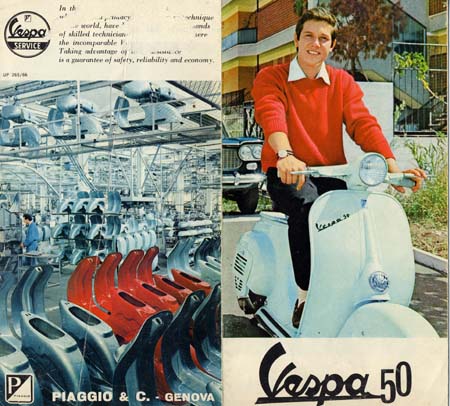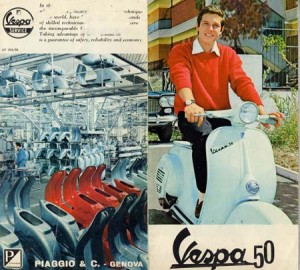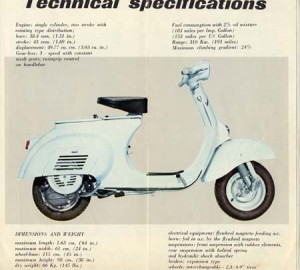|
This page was exported from The Vespa Guide
[ http://vespaguide.com ] Export date: Fri Apr 4 4:01:37 2025 / +0000 GMT |
Vespa Small Frame Buyers Guide (Part 3) Originally Posted: Published: http://www.scooteristscene.comTUNING THE SMALL FRAME VESPA
Now I don't claim to be a tuning guru, so please don't bombard the Letters Pages about my lack of knowledge about bhp figures, power spreads, etc. But if you wish to get down 'n' dirty with these things, once again there's various forums which will satisfy your hunger. While this isn't a comprehensive guide to small frame tuning (which will probably be covered more in-depth in future issues), here's a quick rundown on some of the tuning cylinders available on the market: DR/OLYMPIA 130 The cheapest of all the 130cc barrel kits and while not being the quickest, it's pretty durable. It's basically a copy of the ET3 cylinders apart from the transfer ports arranged differently and the compression being raised. The DR is a cast cylinder with a 57mm bore, 51mm stroke and has five transfer ports. All this adds up to a bit more oomph and usable power (about 8bhp), but in standard trim it's not going to win any race medals. There are DR kits also available in 75cc, 85cc and 102cc. Expect to pay anything from £80 to £100 for the 130cc kit. POLINI 130 A popular choice with many tuners. The Polini barrel is a more ‘torquey' kit, which is suitable for a touring set up – though with fettling, it can be made into a race motor. The cylinder has a 57mm bore with a 51mm stroke, which is cast iron and sports six transfer ports. A standard cylinder with a decent carburettor should knock out around 12bhp, though this could be increased to around 19bhp with the necessary tuning and parts. For smaller engine blocks, Polini produce a 50cc, 75cc, 85cc, 102cc and 112cc to suit all pockets and licences. The 130cc kit should set you back around £120. MALOSSI 135 Malossi has an excellent reputation due to its T5 172 and P2 210 barrel kits, which many scooterists have happily thrashed over the years. The 135cc is no exception and with its high revving nature, good potential for tuning and decent price bracket. The Malossi has a 57.5mm bore, a 51mm stroke and cast iron construction (actual size is 132.43cc). The performance you can expect from a standard cylinder can be around 12-14bhp depending on your exhaust and carb set up. The Malossi small frame family comes in 75cc, 105cc, 115cc. The 135 kit retails (depending on the dealer) around £130. FALC 153CC Now this is a serious piece of kit! The Falc is one of a new generation of barrel kits for the small frame range and it's a bit of an animal! The cylinder has a 54mm stroke, 60mm bore and has a Nicasil lined alloy cylinder. It also has a direct reed valve inlet, five transfer ports and a bridged exhaust port. All this adds up to an engine that can produce up to 25bhp with scud missile-like acceleration. However, all this mentalist material doesn't come cheap – expect to pay over £500 for the cylinder alone! You then need to fork out another couple of hundred pounds for the special Falc crank and clutch as well as various other necessary engine components. Your engine rebuild cost will be way over the £1000 mark but if you want the best… The Falc kit is also available in a 138cc version. EARLY ENGINES It's worth noting that pre-1964 engines are difficult to tune and require machining to fit a barrel kit. The spigot size was smaller on these motors. These engines also have a different kick-start mechanism as well as gearbox components. While it's not impossible to use these engines for tuning, it may be cheaper and easier to pick up a later type engine case. When it comes to small frame Vespas, there's no shortage of ‘go-faster' goodies on the market, be it cylinders, carbs, gear up kits and exhausts. For more information, please consult one of the many tuning houses either in this country or abroad. They should be more than happy to help you scare your local boy racers on the ring road! PK50-125 By the late 1970s, Piaggio had sought to revise its range of scooters with new designs. As the Vespa Rally 200 model gave way to the PX, the Primavera/ ET3 was eventually replaced by the new PK range. The sleek, curvaceous styling of the original small frame was replaced with a more angular, square design which many enthusiasts didn't warm to. The frame now featured two panel doors; the left side became a storage area for a spare wheel (like the PX range). A plastic toolbox filled the space behind the legshields and blocky rectangular indicators now adorned the front and rear of the machine. When the PKS was released in 1983 it was available in two engine sizes (50 and 125cc). The 125cc version shared the same engine characteristics as the ET3 such as three cylinder ports and electronic ignition. As the 1980s rolled on the PK range was subjected to a cosmetic makeover resulting in the PKXL range and then the PKXL2 models. These had a more streamlined appearance, with sleeker curves and smoother lines. However, due to poor sales and Piaggio beginning to concentrate on its new range of automatic scooters, the PK ceased production in the early 1990s. The PK50S was produced between 1982 and 1986, with 221,578 being made. The prefix on the engine should read V5X2T, while it should be V5X2M on the engine case. Production of the PK125S lasted from 1982 to 1986. The frame prefix is VMX5T and the engine is VMX5M. 62,606 PK125s rolled off the production line. The PKXL range ran from 1985 to 1993. The PK50XL-125XL frame prefixes are VMX5T for the 50cc, while the 125cc is VMX6T. The engines are stamped V5X3M (50), VMX6M (125). Total production for the PK50XL is 221,578 and 57,014 for the PK125XL. The less popular PK range can be picked up for anything between £500 and £900, depending on the engine size. PRIMAVERA/ET3 Though the first 125cc small frame appeared in 1965 with the VMA1 (named in reference to its frame prefix) in 1967 Piaggio decided to upgrade its specification and named the model the Primavera. These changes included a longer redesigned frame with a toolbox now residing in the left-hand panel, as well as an increase in power. In 1976 the ET3 version of the Primavera was introduced; this model was now fitted with an electronic ignition, as well as an SS90 ‘banana' style expansion chamber. More power was achieved from the engine due to a third transfer port added to the cylinder, increasing it from 5.5 to 7 bhp. The VMA1 was made between 1965 and 1967 with a total production of 17,100. The Primavera ran from 1967 to 1976 and the ET3 was produced between1976 and 1983, totalling 220,342 and 153,212 respectively. Accurately trying to determine when production actually stopped is no easy matter as ET3 models were produced for the Japanese market up to the late 1990s. Frame prefix and engine numbers for the VMA1 are VMAIT and VMA1M. The Primavera is VMA2T and VMA2M; the ET3 prefix is VMBIT while the engine is stamped VMB1M. Being a 125cc, the ET3/Primavera normally sells for £750- £1200. 50 SPECIAL  The 50 Special was released in 1969 it featured a square headlamp, different horncast and tail-light arrangement. At the same time the 50 Elestart was introduced, which was basically a 50 Special with an electric start, though this model was never imported into the UK at the time.The 50 Special was made between 1969 and 1983 with a total of 659,966 being produced. The frames are stamped V5BIT, V5B3T and V5A2T, while the engines should be stamped V5A2M, V5B1M, or V5B3M. |
|
Post date: 2014-10-12 03:44:27 Post date GMT: 2014-10-12 03:44:27 Post modified date: 2016-06-20 07:48:17 Post modified date GMT: 2016-06-20 07:48:17 |
| Powered by [ Universal Post Manager ] plugin. HTML saving format developed by gVectors Team www.gVectors.com |
